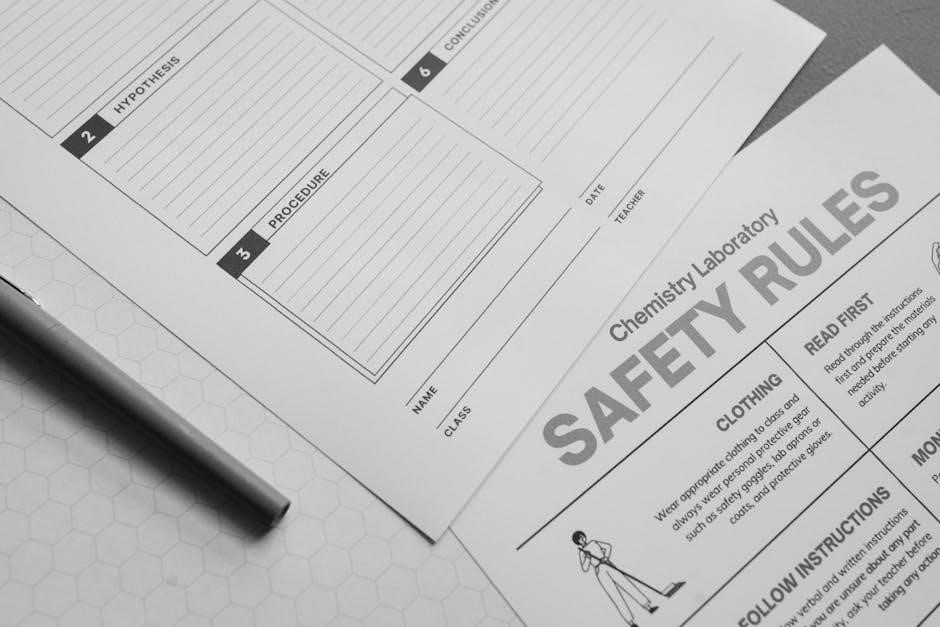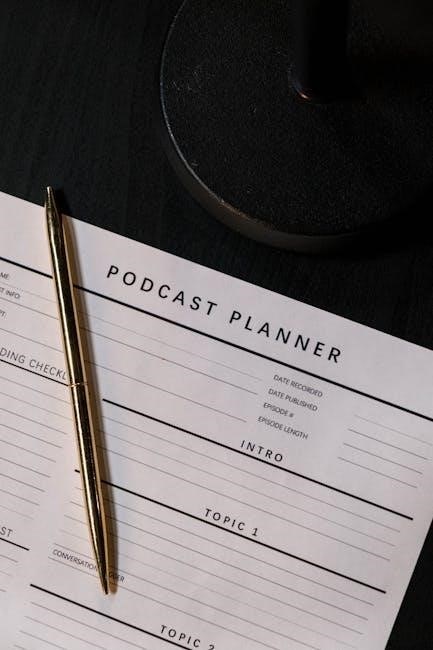Understanding Codependency

Codependency involves emotional dependency on others, often leading to enabling behaviors, people-pleasing, and fear of abandonment. It disrupts healthy boundaries and fosters dysfunctional relationship patterns, which worksheets can help address.
What is Codependency?

Codependency is a relationship dynamic where individuals prioritize others’ needs over their own, often enabling harmful behaviors. It stems from low self-esteem and fear of abandonment, fostering people-pleasing and lack of boundaries. This pattern, rooted in childhood experiences like dysfunctional family environments, disrupts personal growth and healthy communication. Codependency isn’t limited to romantic relationships; it can affect friendships and family dynamics. Worksheets help identify these traits, offering tools for self-reflection and change. By addressing these patterns, individuals can develop healthier relationships and emotional well-being. Understanding codependency is the first step toward recovery, enabling individuals to break free from cycles of dependency and build more balanced connections. Worksheets provide practical exercises to explore these dynamics, making recovery more accessible and structured. Recognizing codependency’s signs is essential for personal growth and fostering fulfilling relationships. Worksheets offer a guided approach to understanding and overcoming codependent tendencies effectively. This awareness is crucial for long-term emotional health and relationship harmony.
Signs and Symptoms of Codependency
Codependency often manifests through people-pleasing, fear of abandonment, and an excessive need for control. Individuals may struggle with setting boundaries, enabling harmful behaviors in others, and neglecting their own needs. Common symptoms include perfectionism, difficulty expressing emotions, and a tendency to prioritize others’ happiness over their own. They may also exhibit low self-esteem, repress emotions to avoid conflict, or become overly dependent on relationships for a sense of identity. Enmeshment in relationships, where personal boundaries blur, is another key indicator. These patterns can lead to emotional burnout, resentment, and unhealthy cycles in relationships. Recognizing these signs is crucial for addressing codependency and fostering healthier interpersonal dynamics.
The Difference Between Codependency and Healthy Relationships
Codependency is often mistaken for love, but it differs significantly from healthy relationships. Healthy relationships are built on mutual respect, boundaries, and interdependence, where both partners maintain their individuality and emotional well-being. In contrast, codependency involves emotional dependency, enabling behaviors, and a loss of personal identity. Codependent relationships often revolve around one person’s needs, leading to imbalance and resentment. Worksheets on codependency, such as boundary-setting exercises, can help individuals identify these patterns and transition toward healthier dynamics. By fostering self-awareness and communication skills, these tools empower individuals to redefine their relationships and cultivate emotional independence. Understanding this distinction is crucial for personal growth and fostering meaningful connections.

The Role of Worksheets in Addressing Codependency
Worksheets help individuals identify codependent patterns, set boundaries, and improve self-worth, offering structured exercises for self-awareness and personal growth in a practical, accessible format.
Why Codependency Worksheets Are Effective
Codependency worksheets are effective because they provide structured, practical exercises to identify and address codependent behaviors. They guide individuals through self-reflection, helping them recognize patterns like people-pleasing or enmeshment. By offering actionable steps, worksheets empower users to set boundaries, improve communication, and build self-worth. Their clarity and focus make complex emotional issues more manageable, fostering personal growth. Worksheets are particularly useful in therapy sessions, offering a tangible tool for clients to explore their feelings and behaviors. They also serve as a resource for independent learning, allowing individuals to work at their own pace. Overall, worksheets are a powerful, accessible way to address codependency, promoting lasting change and emotional healing. Their effectiveness lies in their ability to translate abstract concepts into actionable, measurable steps. This makes them an invaluable resource for both professionals and individuals seeking to overcome codependent tendencies.
Types of Codependency Worksheets Available
Codependency worksheets are diverse, offering tailored exercises to address specific issues. Boundary-setting exercises help establish limits, while communication skills worksheets improve expression and active listening. Self-worth activities focus on building self-esteem, and emotional triggers identification guides users to recognize and manage their reactions. Additionally, codependency tests provide self-assessment tools to identify tendencies and patterns. These resources are often available as printable PDFs, making them accessible for personal use or therapeutic settings. Each type of worksheet targets different aspects of codependency, ensuring a comprehensive approach to understanding and overcoming it. They serve as practical tools for individuals seeking to break free from unhealthy relationship dynamics and cultivate healthier, more balanced connections. By addressing various facets of codependency, these worksheets offer a structured path toward personal growth and recovery.
How to Use Worksheets for Personal Growth
Using codependency worksheets can be an empowering journey toward healthier relationships and self-awareness. Start by identifying patterns in your behaviors and emotions, then practice setting boundaries. Engage in exercises that enhance communication skills and build self-esteem. Regularly reflect on your progress and explore ways to detach in relationships. Worksheets provide structured guidance, helping you recognize emotional triggers and develop healthier coping mechanisms. By committing to these exercises, you can gradually break free from codependent tendencies and foster more balanced connections with others.
- Begin with self-assessment to understand your codependent behaviors.
- Practice boundary-setting exercises to establish healthy limits.
- Engage in communication drills to improve interpersonal interactions.
- Focus on building self-worth through affirmations and reflection.
- Identify emotional triggers and develop strategies to manage them.
Consistency is key to lasting change, so incorporate worksheets into your daily or weekly routine for gradual, meaningful growth.

Popular Codependency Worksheets
Popular worksheets include a 15-question codependency test, boundary-setting exercises, and guided activities for communication and self-worth. The “Am-I-Co-Dependent-Bro-4002” PDF offers practical tools for self-assessment and growth.
Codependency Test: Assessing Your Tendencies
A codependency test is a valuable tool for identifying patterns of emotional dependency and enabling behaviors. These assessments typically include a series of questions that evaluate how individuals interact in relationships, prioritize others’ needs over their own, and struggle with boundaries. For example, questions might focus on tendencies like people-pleasing, fear of abandonment, or difficulty in expressing personal needs. By completing a codependency test, individuals can gain clarity on whether their behaviors align with healthy relationship dynamics or if they may benefit from targeted exercises or therapy. Many worksheets, such as the “Am I Codependent?” quiz, offer a straightforward way to self-assess and understand the extent of codependent tendencies. This awareness is the first step toward personal growth and developing healthier relationship patterns.
Boundary Setting Exercises
Boundary setting exercises are essential for addressing codependency, as they help individuals establish and communicate their limits effectively. Worksheets often include prompts to identify personal boundaries, practice assertive communication, and reflect on past boundary violations. These exercises encourage users to differentiate between their needs and others’, fostering healthier relationships. Practical steps like creating a boundary list or role-playing conversations are common. By regularly practicing these exercises, individuals can develop the confidence to maintain their boundaries without guilt or fear of conflict. These tools empower personal growth and are a cornerstone of codependency recovery. Download free boundary-setting worksheets to start your journey toward healthier relationships today.
Communication Skills Worksheets
Communication skills worksheets are essential tools for addressing codependency, as they help individuals express their needs and emotions effectively. These exercises often include guided prompts to practice active listening, assertiveness, and setting boundaries. By improving communication, individuals can reduce misunderstandings and foster healthier interactions. Worksheets may also focus on identifying patterns of people-pleasing or passive-aggressive behaviors, encouraging honest and direct expression. Many PDF resources provide exercises like role-playing scenarios or writing activities to clarify personal boundaries and expectations. Enhancing communication skills is a cornerstone of overcoming codependency, as it empowers individuals to build mutual respect and understanding in relationships. Regular practice with these worksheets can lead to more authentic and balanced connections, reducing the emotional strain of codependent dynamics;
Self-Worth and Self-Esteem Building Activities
Building self-worth and self-esteem is a critical step in overcoming codependency. Worksheets designed for this purpose often include exercises like identifying personal strengths, writing affirmations, and reflecting on past achievements. These activities help individuals recognize their value beyond their relationships. One popular worksheet involves creating a self-care plan, which encourages setting boundaries and prioritizing personal needs. Another exercise focuses on challenging negative self-talk by replacing it with positive, empowering statements. Some worksheets guide users to explore their hobbies and interests, fostering a sense of identity separate from others. By completing these exercises, individuals can develop a healthier self-image and reduce their reliance on others for validation. Over time, these activities empower individuals to cultivate confidence and independence, which are essential for forming balanced relationships. Regular practice of these exercises can lead to lasting improvements in self-esteem and overall well-being.
Emotional Triggers Identification Exercise
Identifying emotional triggers is a crucial step in addressing codependency. Worksheets designed for this purpose guide individuals to recognize patterns of feelings and reactions tied to specific situations or people. By reflecting on past experiences, users can pinpoint moments when they felt overwhelmed, anxious, or reactive. This exercise encourages self-awareness, helping individuals understand how their emotions drive behaviors like people-pleasing or avoidance. Many worksheets include prompts such as listing triggers, rating their intensity, and exploring underlying causes. This process fosters insight into how codependent tendencies are activated, enabling individuals to develop healthier coping mechanisms. Regular practice of this exercise can lead to improved emotional regulation and more balanced relationships. It serves as a foundational tool for personal growth and recovery from codependency.

Downloading and Using Codependency Worksheets
Codependency worksheets are widely available as free PDF downloads, offering guided exercises for boundary-setting, communication, and self-worth. They provide practical tools for personal growth and healing from codependent patterns.
Free Codependency Worksheets PDF Resources
Free codependency worksheets in PDF format are widely available online, offering practical tools for self-reflection and growth. These resources often include exercises like boundary-setting activities, communication skill-builders, and self-worth assessments. Many worksheets are designed to help individuals identify codependent patterns, such as people-pleasing or emotional dependency. Some popular options include printable PDFs with guided exercises on detachment, emotional triggers, and relationship dynamics. Websites like Pinterest and Therapist Aid provide access to these materials, often requiring no sign-up or payment. For example, a 15-question codependency test can help users assess their tendencies and understand areas for improvement. These worksheets are ideal for personal use or therapeutic settings, making recovery more accessible and affordable for everyone.
Premium Worksheets and Guides
Premium codependency worksheets and guides offer advanced tools for deeper self-reflection and structured growth. These resources often include detailed exercises tailored to specific aspects of codependency, such as financial dependency or emotional enmeshment. Unlike free versions, premium materials may feature interactive elements, video guides, or customizable templates. They are designed to provide a comprehensive approach to recovery, with expert-crafted content that addresses complex emotional patterns. Many premium worksheets are available in downloadable PDF formats or as part of online courses, offering convenience and privacy. They cater to individuals seeking personalized growth strategies and those in therapy who need supplemental aids. Investing in premium resources can enhance your journey toward healthier relationships and emotional independence, offering a more robust framework for lasting change and personal development.
How to Choose the Right Worksheet for Your Needs
Selecting the right codependency worksheet involves identifying your specific needs and goals. Consider whether you need to focus on boundary-setting, communication, or self-esteem building. Look for worksheets that align with your personal issues, such as people-pleasing or emotional triggers. Assess the format—some worksheets are ideal for individual use, while others are designed for couples or therapy sessions. Check if the worksheet offers guided exercises or reflection prompts to help you process your thoughts. Additionally, determine if you prefer free downloadable PDFs or premium guides with in-depth resources. Start with a codependency test to identify areas needing attention, then choose worksheets that target those specific behaviors. The right worksheet will provide clarity, practical tools, and a structured path toward personal growth and healthier relationships.

Applying Worksheets to Real-Life Situations
Codependency worksheets offer practical tools for real-life situations, helping individuals identify emotional triggers, set healthy boundaries, and improve communication, fostering personal growth and healthier relationships.
Case Studies: Overcoming Codependency with Worksheets
Real-life examples illustrate the effectiveness of worksheets in tackling codependency. For instance, Sarah, a 35-year-old, used boundary-setting exercises to establish limits with her partner, reducing enmeshment. The structured format helped her identify patterns of people-pleasing and develop healthier communication habits. Over six months, Sarah reported improved self-esteem and more balanced relationships.
Another case involved Mark, who struggled with emotional dependency. Through worksheets focused on self-worth and emotional triggers, he learned to recognize and manage his need for constant validation. These tools provided a safe space for introspection, empowering him to assert his needs without guilt.
Such case studies highlight how worksheets can guide individuals toward sustainable growth, offering practical steps to break free from codependent cycles. They serve as powerful reminders of the transformative potential of structured self-reflection and practice.
Integrating Worksheets into Therapy Sessions

Codependency worksheets can be invaluable tools in therapy sessions, providing structured exercises to explore patterns, set boundaries, and improve communication. Therapists often use these worksheets to guide clients in identifying triggers, practicing self-care, and developing healthier relationship habits. By incorporating worksheets, therapists can create a collaborative environment where clients actively engage in their recovery. For example, boundary-setting exercises can help clients visualize and articulate their limits, while communication skills worksheets enable them to practice expressing needs effectively. These tools also serve as a progress tracker, allowing both therapist and client to monitor growth over time. Additionally, worksheets can be tailored to address specific issues, making therapy more personalized and effective. Overall, integrating worksheets into therapy sessions enhances self-awareness, fosters accountability, and equips clients with practical skills for lasting change.
Using Worksheets in Couples Therapy
Codependency worksheets are valuable tools in couples therapy, helping partners identify and address dysfunctional patterns. They facilitate open communication and mutual understanding, fostering healthier interactions. These exercises often focus on setting boundaries, improving conflict resolution, and enhancing emotional expression. Couples can explore topics like fair fighting, relationship building, and empathy through guided activities. Worksheets also encourage accountability and introspection, allowing each partner to recognize their role in the relationship dynamics. By working together on these exercises, couples can break cycles of codependency and develop more balanced, respectful connections. Therapists often integrate these tools to create a structured environment for growth and healing. Regular use of worksheets promotes long-term progress and strengthens the foundation of the relationship.

Additional Resources for Recovery
Explore books like Codependent No More and online communities for ongoing support. Tools like Therapist Aid offer diverse resources, including worksheets, to enhance your recovery journey effectively.

Recommended Books on Codependency
Several books are highly recommended for understanding and overcoming codependency. Codependent No More by Melody Beattie is a classic, offering practical insights and strategies for breaking free from codependent patterns. Another notable book is The Language of Letting Go, also by Beattie, which provides daily affirmations and reflections for healing. Boundaries by Dr. Henry Cloud and Dr. John Townsend is essential for learning to set healthy limits in relationships. Additionally, Healing Codependency by Kathryn Maeglin focuses on self-discovery and empowerment. These books complement codependency worksheets by providing deeper understanding and actionable steps for recovery. They are available in paperback, e-book, and audiobook formats, making them accessible to everyone.
- Codependent No More
- The Language of Letting Go
- Boundaries
- Healing Codependency
These resources are invaluable for anyone seeking to overcome codependency and build healthier relationships.
Online Communities for Support
Online communities play a vital role in providing emotional support and resources for individuals addressing codependency. Platforms like Pinterest offer curated ideas and inspiration for overcoming codependency, with many users sharing worksheets and exercises. Additionally, forums and social media groups dedicated to mental health provide safe spaces for sharing experiences and connecting with others facing similar challenges. Websites like Therapist Aid and specialized codependency support groups offer access to guided exercises, downloadable PDFs, and expert advice. These communities foster a sense of belonging and accountability, helping individuals stay motivated on their recovery journey. By engaging with these resources, individuals can gain practical tools and emotional support to navigate codependent patterns effectively.
Therapist Aid and Other Helpful Tools
Therapist Aid offers a variety of codependency worksheets designed to help individuals identify and address codependent patterns. These tools include guided exercises on setting boundaries, improving communication, and recognizing emotional triggers. One popular resource is a 15-question codependency test, which helps users assess their tendencies and understand the root causes of their behaviors. Additionally, worksheets focused on self-worth and detachment provide practical steps for personal growth. These resources are user-friendly and can be downloaded as PDFs, making them accessible for both therapists and individuals working independently. By leveraging these tools, individuals can gain clarity on their relationship dynamics and develop healthier ways of interacting with others. Therapist Aid’s resources are particularly valuable for those seeking structured guidance to overcome codependency and foster emotional well-being.
Codependency worksheets are effective tools for personal growth and recovery. Consistency and self-awareness are key to lasting change. Worksheets empower individuals to break patterns and build healthier relationships.
The Importance of Consistency in Recovery
Consistency is crucial in overcoming codependency, as it fosters lasting change and reinforces healthy patterns. Regular use of codependency worksheets helps individuals identify and challenge harmful behaviors, promoting self-awareness and accountability. By committing to daily or weekly exercises, individuals can track progress, build resilience, and develop emotional regulation skills. Worksheets provide a structured routine, ensuring continuous growth and preventing relapse into old habits. Over time, consistency strengthens self-esteem and boundary-setting abilities, enabling individuals to form healthier relationships. Recovery is a journey, and steady effort ensures sustainable transformation.
Final Thoughts on Using Worksheets Effectively
Codependency worksheets are powerful tools for fostering self-awareness and personal growth. They provide structured exercises to identify patterns, set boundaries, and improve communication. Regular use can lead to lasting change.
Consistency is key; incorporating worksheets into daily routines helps reinforce healthy habits. They also promote self-reflection, enabling individuals to address emotional triggers and build self-worth. For optimal results, combine worksheets with therapy or support groups to enhance recovery.

